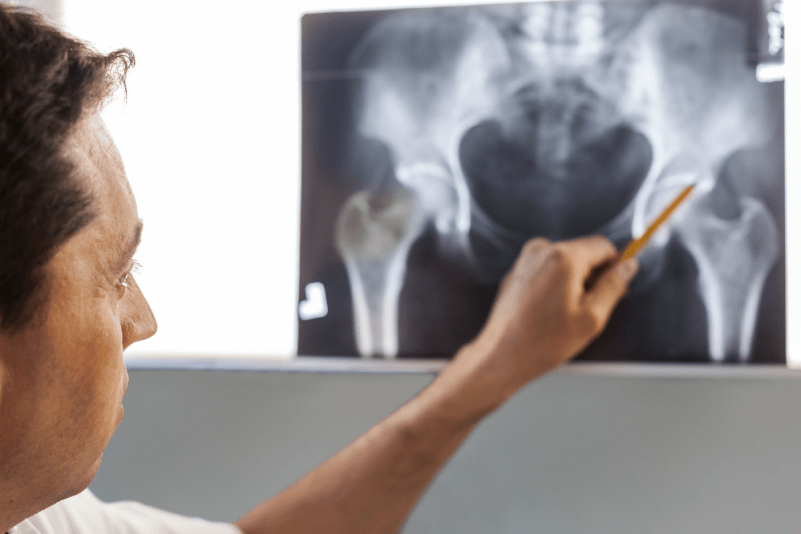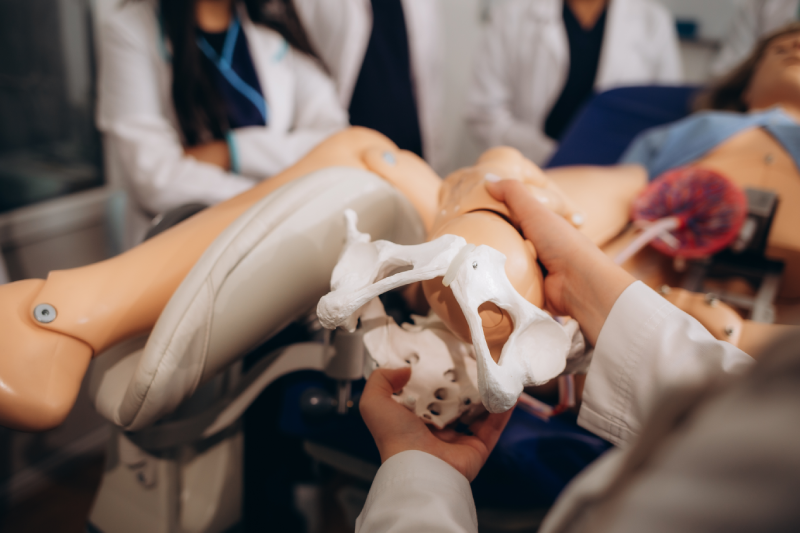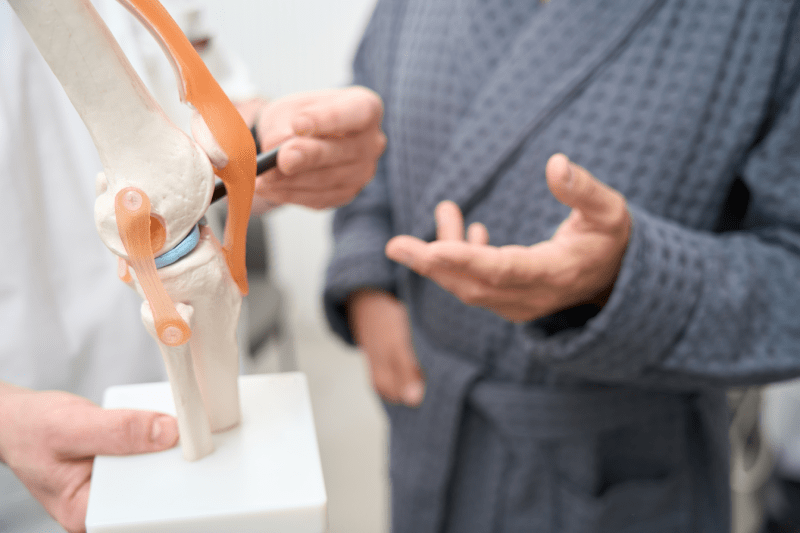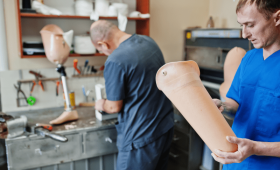What is Hip Replacement Surgery?
Hip replacement surgery is a surgical procedure performed to repair damage to the hip joint caused by advanced wear and tear, osteoarthritis, or trauma. In this procedure, the damaged joint cartilage and bone tissues are removed and replaced with an artificial joint (prosthesis).
The prosthesis consists of two main parts called the ball and socket. The purpose of this surgery is to relieve the patient’s hip pain, increase their mobility, and significantly improve their quality of life. The surgery can be performed using both robotic and traditional methods.
What is Robotic Hip Replacement Surgery?
Robotic hip replacement surgery is an advanced technology method in which the hip prosthesis is implanted using robotic surgical systems. Before the surgery, the surgeon creates a three-dimensional model of the patient’s hip joint to determine the ideal position for the prosthesis.
During the surgery, the surgeon uses the robotic arm as a guide to make bone cuts and place the prosthesis with millimeter-level precision. This technology aims to increase the success of the surgery by offering a level of accuracy that the human hand cannot achieve.
What is Traditional Hip Replacement Surgery?
Traditional hip replacement surgery is the standard surgical method where the surgeon manually accesses the hip joint and places the prosthesis. During the operation, the surgeon relies on their own experience and knowledge to determine the bone cuts and prosthesis position. This method has been successfully used for many years and is the most common hip replacement technique worldwide. When performed by experienced surgeons, it yields very safe and effective results.
What is the Main Difference Between Robotic and Traditional Surgery?
The main difference between robotic and traditional surgery is the precision and guidance in placing the prosthesis. While in the traditional method the surgeon relies on their own dexterity and experience, in the robotic method, surgical planning and execution are supported by the robotic system’s millimeter-level precision. This ensures the prosthesis is placed at the correct angle and depth, minimizing potential complications and the need for revision surgery.
What Are the Advantages of Robotic Hip Replacement Surgery?
The biggest advantage of robotic hip replacement surgery is the placement of the prosthesis with the highest precision. This extends the life of the prosthesis and reduces the risk of post-operative hip dislocation. Additionally, the three-dimensional planning offered by the robotic system allows for smaller incisions, which leads to less blood loss, less tissue damage, and a faster recovery after surgery.
What Are the Advantages of Traditional Hip Replacement Surgery?
The biggest advantage of traditional hip replacement surgery is that it is a method that has been used for many years with proven results. In the hands of an experienced surgeon, this method also yields very successful outcomes. Furthermore, it is generally more cost-effective compared to robotic surgery and can be completed in a shorter time. The traditional method can adapt more easily to all types of patients and joint conditions.

Which Patients Are Suitable for Robotic Surgery?
Robotic hip replacement surgery is generally suitable for patients who need a prosthesis due to conditions such as hip osteoarthritis, avascular necrosis, or rheumatoid arthritis. Especially young and active patients can benefit more from robotic surgery due to the extended life of the prosthesis and faster recovery. However, since every patient’s condition is different, the decision on suitability is made based on the surgeon’s evaluation.
What is the Pre-Surgery Preparation Process Like?
Before the surgery, the surgeon will request various tests (such as blood tests, ECG, and a chest X-ray) to evaluate the patient’s overall health. The patient’s medications are reviewed, and it is determined when blood thinners, in particular, should be stopped before the surgery. To ensure the surgery is successful and to reduce the risk of infection, the patient may be advised to reach an ideal weight and quit smoking.
How Long Does Robotic Surgery Take?
The duration of robotic hip replacement surgery varies depending on the patient’s condition and the surgeon’s experience. It can generally take a little longer than traditional surgery because there is a detailed three-dimensional planning phase before the operation. On average, this surgery is completed in 1 to 2 hours. This time also includes additional steps such as setting up the robotic system and adjusting the navigation.
How Long Does Traditional Surgery Take?
Traditional hip replacement surgery is generally completed in a shorter time. On average, this surgery takes between 60 to 90 minutes. This duration can vary depending on the surgeon’s experience and the condition of the patient’s hip joint. The faster completion of the surgery shortens the time the patient is under anesthesia.
How is Post-Surgery Pain Management Handled?
Post-surgery pain management is critical for the patient’s comfort and recovery process. During their hospital stay, patients are given pain relievers intravenously. Upon discharge, oral pain medications are prescribed. Pain can be intense in the first few days, but it can be controlled with medication, ice application, and rest. Pain is generally less severe with robotic surgery.
When Does Physical Therapy Begin and How Long Does It Last?
Physical therapy after hip replacement surgery usually begins the very next day. In the initial phase, basic movements such as walking and climbing stairs are practiced with the help of a physical therapist. The physical therapy program includes regular exercises to help the patient regain strength and mobility and generally lasts for 3 to 6 months. Regular exercises are vital for the success of the prosthesis.
How Long is the Hospital Stay After Surgery?
The length of the hospital stay after hip replacement surgery varies depending on the patient’s overall health and the type of surgery. Generally, patients stay in the hospital for 2 to 4 days after the operation. Patients who have robotic surgery can sometimes be discharged earlier due to less pain and faster recovery.
What is the Lifespan of the Prosthesis?
The lifespan of modern hip prostheses used today is quite long. A hip prosthesis is generally expected to function without problems for 15 to 25 years. The lifespan of the prosthesis can vary depending on the patient’s age, activity level, and the type of prosthesis. Prostheses placed with robotic surgery are thought to have a longer lifespan due to their high precision.
What Are the Risks of Robotic Surgery?
Although robotic hip replacement surgery is a safe method, it carries some risks like any surgical procedure. These risks include infection, bleeding, fractures around the prosthesis, leg length inequality, and nerve damage. However, it is stated that these risks are lower than with traditional surgery due to the precision offered by the robotic system.
What Are the Risks of Traditional Surgery?
The risks of traditional hip replacement surgery are similar to those of robotic surgery. Risks such as infection, bleeding, prosthesis loosening, hip dislocation, and blood clots exist. When performed by an experienced surgeon, these risks are minimized. The risks should be explained in detail to the patient before the surgery.
Is the Cost of Surgery Different Between Robotic and Traditional Methods?
Yes, robotic hip replacement surgery is generally more expensive than traditional surgery. This cost difference stems from the robotic system itself and the licensing fees for the technology used. However, this additional cost can be balanced by long-term benefits such as an extended prosthesis lifespan and a lower risk of complications. In Turkey, the prices for both methods vary by hospital and city.
Does Insurance Cover Robotic Surgery?
Private health insurance companies in Turkey may cover the costs of robotic hip replacement surgery depending on the policy coverage. However, some insurance companies may require an additional premium for robotic surgery or may exclude this method from their coverage. Therefore, it is very important to contact your insurance company before the surgery to learn the details of your policy coverage.
When Can I Start Walking Normally After Surgery?
After hip replacement surgery, patients usually begin walking with support, assisted by a physical therapist, the day after the operation. The time it takes to walk completely unsupported can vary from a few weeks to several months, depending on the patient’s general health and the progress of rehabilitation. Patients who have robotic surgery can generally return to their normal gait in a shorter time.
When Can I Return to Exercise and Sports?
During the post-operative recovery process, patients who have had hip replacement surgery can usually return to light exercises (such as walking, swimming) after 3 to 6 months. For more strenuous sports (such as running, tennis, skiing), a doctor’s approval should be obtained, and they should generally be started after 6 months. It is important to avoid high-impact sports to extend the life of the prosthesis.
How is the Recovery Process Different After Robotic Surgery?
Because robotic surgery allows for smaller incisions and less tissue damage, the post-operative recovery process is generally faster and less painful. Patients can get out of bed and start physical therapy sooner after the surgery. This can shorten the hospital stay and help them return to normal life more quickly.
In What Situations is Robotic Surgery Not Recommended?
In some situations, robotic hip replacement surgery may not be recommended. The traditional method may be preferred if the patient’s bone structure is not suitable for the robotic system’s planning or if there is an advanced degree of joint deformity. Additionally, if the patient’s overall health is not suitable for the longer anesthesia time required for robotic surgery, the traditional method may be more appropriate.
Why is Hip Replacement Surgery Preferred in Turkey?
Turkey is a globally popular destination for hip replacement surgeries. The main reasons for this include hospitals with modern technology, expert and experienced surgeons, and more affordable costs compared to other countries. Furthermore, the high-quality healthcare services and rehabilitation opportunities offered after surgery also play an important role in why patients choose Turkey.
Does Leg Length Inequality Occur After Surgery?
Leg length inequality after hip replacement surgery is a potential risk in both traditional and robotic surgery. However, robotic surgery aims to minimize this risk through pre-operative three-dimensional planning and millimeter-level precision. In the traditional method, an experienced surgeon’s expertise is critical to reducing this risk.

What Should Be Paid Attention to After Surgery?
After surgery, some rules must be followed to extend the life of the prosthesis and prevent complications. It is important to strictly follow the exercise program recommended by the physical therapist, avoid overstraining the hip, and be careful against trauma such as falling from a height. Regular doctor check-ups are also vital to monitor the condition of the prosthesis.
What Does Revision Surgery Mean?
Revision surgery is the procedure of removing a previously implanted hip prosthesis and replacing it with a new one, due to reasons such as the prosthesis reaching the end of its lifespan, loosening, infection, or fracture. Robotic surgery aims to reduce the need for revision surgery due to the high precision of the initial prosthesis placement.
What Are the Most Important Success Criteria for the Surgery?
The success of hip replacement surgery is not limited to the correct placement of the prosthesis. The most important success criteria are that the patient’s post-operative pain is completely gone, their hip mobility increases, and they can comfortably perform daily life activities. The long life of the prosthesis is also an indicator of success.
In What Other Surgeries is the Robotic System Used?
Robotic surgical systems are frequently used in knee replacement surgeries in addition to hip replacement surgeries. These technologies guide the surgeon to make bone cuts and place the prosthesis in the most accurate way during the operation. Thanks to these systems, the precision and patient comfort of joint replacement surgeries are increased.
How Can I Find the Best Surgeon in Turkey?
To find the best surgeon in Turkey, you should first research surgeons who specialize in orthopedics and traumatology, particularly those with experience in hip surgery. It is important to read patient reviews and get information about the surgeon’s past success rates and patient satisfaction. A reliable surgeon will patiently answer your questions and inform you in detail about all stages of the surgery.
How Should Post-Surgery Nutrition Be?
Nutrition is very important to support the post-operative recovery process. Foods high in protein (chicken, fish, eggs) help with muscle repair. Foods rich in calcium and Vitamin D (dairy products, green leafy vegetables) support bone health. Adequate fluid intake is also vital during the post-operative period.



